Aceh: Story of aid success and failure
A year after the tsunami laid havoc to Aceh, tens of thousands of people still live in a vast archipelago of shanty towns made of scrap wood.

Along the coast of the Indonesian province, little remains of villages but swampland and ankle-high rubble.
In hurriedly built plywood barracks, survivors are jammed together in windowless rooms.
Billions of dollars were pledged to help the survivors of the tsunami, which left at least 216,000 people dead or missing and displaced more than two million more. But many people remain desperately frustrated.
One man, Zoelfitri, said: “We know a lot of money is going to Aceh, but where is it? Where are the buildings? Where is the construction?” Like many Indonesians, he uses only one name.
He lives in a homemade shanty on the fringes of the provincial capital of Banda Aceh, and cares for nearly a dozen relatives, siblings, and children who lost parents in the tsunami.
Slow rebuilding
But to see only the destruction is to miss what else has come to Aceh since the disaster: the villages slowly rebuilding with workers’ help; the miles of new sewage pipes and hospital emergency rooms.
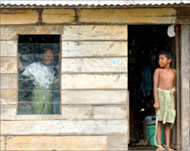 |
|
Tsunami survivors are living in |
One year later, Aceh is testament both to the successes and the failures that can come from billions of dollars in aid money.
Aceh suffered most from the killer waves spawned by the massive undersea earthquake on 26 December last year.
Eleven other Indian Ocean rim countries were hit – Sri Lanka, India and Thailand suffered thousands of deaths.
Within hours of the waves striking shore, the international aid community began one of the biggest emergency assistance programmes in history.
Hurried aid
Indonesia estimated it needed $5 billion and received pledges totalling $6.5 billion.
Nearly $4.5 billion has been collected, according to the UN.
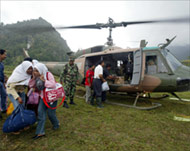 |
|
Tonnes of food aid were flown |
Where has the money gone?
By the end of the year, the World Food Programme estimates it will have spent more than $125 million in Aceh, including nearly $20 million on helicopters and airplanes that have ferried 40,000 passengers and 1000 tons of cargo and $26 million on 72,000 tonnes of food aid.
- Britain’s Oxfam has spent $11.5 on public health, water and sanitation programmes in Aceh.
- Save the Children spent more than $1 million buying textbooks and school supplies. Billions, though, remain unspent, now earmarked for the years of work ahead. Save The Children, for instance, still has nearly two-thirds of its $157 million budget for Indonesia, now planned for use through 2009.
Enormous tasks
The tasks remaining are immense: rebuilding the road on the battered western coast; building tens of thousands of homes; digging pipe networks to bring clean water.
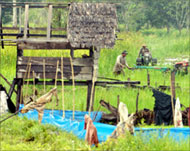 |
|
Problems of land titles quickly |
Aid officials say reconstruction must be viewed in the long-term, despite pressure to get things done faster.
The International Federation of Red Cross and Red
Crescent Societies’ John Sparrow said: “We don’t want the situation where the pressure to spend money makes us do things so quickly.”
In the first few days, aid workers were stunned by what they found. Corpses filled the streets of Banda Aceh.
Entire villages had disappeared.
Hunger and disease threatened to kill still more people.
The local government had basically ceased to exist. Officials were dead, hospitals destroyed, power and phone services were gone.
The result was an invasion of good intentions and almost no oversight.
Banda Aceh
Aljazeera’s correspondent in Banda Aceh, Othman al-Batiri, said that results of a survey published on Monday indicate that only 27% of residents there are satisfied with the reconstruction and aid they have received.
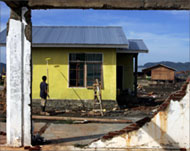 |
|
Survey: Only 27% of Acehnese |
Thousands still live in temporary shelter such as tents.
The political feelings and position of the Acehnese towards the Indonesian government will change, if it meets the demands of reconsruction, he said.
If the government does not fulfil its obligations, Acehnese will feel inclined to support the Aceh liberation movement and call for more demands, including that of self-rule and independence, according to al-Batiri.
Aljazeera has said that leaders of the liberation movement are to meet the Indonesian president on Tuesday. This will be the first meeting between separatists and and the president since 1976, reports al-Batiri.
‘Messy relief operation’
The early days were chaotic as planes and helicopters quickly began ferrying in everything, from surgeons to high-calorie food bars.
|
“We know a lot of money is going to Aceh, but where is it? Where are the buildings? Where is the construction?” Zoelfitri |
Soon, at least 200 aid agencies were working in Aceh.
Intense competition quickly built among aid agencies eager to “plant the flag”.
“The result was a messy relief operation,” according to a recent Red Cross report.
Aid co-ordination meetings were barely controlled chaos.
Workers laid claim to villages they had “discovered” and made promises that often went unfulfilled.
As the meetings became known for their disorganisation, many people began avoiding them, making co-ordination even more difficult.
Money was part of the problem.
In major humanitarian emergencies, the UN is often the biggest financial player, doling out funding to agencies for particular projects.
Problems tackled
This time the roles were reversed, as aid agencies arrived in the tsunami-hit regions with enormous financial resources.
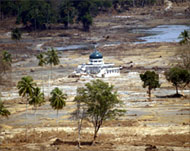 |
|
Entire villages were wiped out |
Up to $1.4 billion was pledged to the UN for tsunami work, but nearly four times that much – $5.5 billion – was pledged to other organisations, the UN says.
When Kuntoro Mangkusubroto, a former minister famous for remaining untainted by corruption, took over as head of Aceh’s reconsturction agency, he was shocked at the chaos.
“There are no roads being built, there are no bridges being built, there are no harbours being built,” he said in May.
He cast aside much of the government’s massive reconstruction plan, brought in outside consultants and auditors, asked for community input, and pushed problems into the open.
‘Unacceptable’
Problems such as land titles and timber shortages quickly mounted.
When Sumatra’s brutal heat gave way to the rainy season, thousands were still leaving in makeshift accommodation.
Eric Morris, the UN Recovery Co-ordinator for Aceh, said recently: “For the survivors who are in the tents, the conditions are unacceptable. There is no other word for it.”
Villagers living in shacks fashioned from plastic sheeting and scrap wood are told houses are on the way. But for now, they must wait.